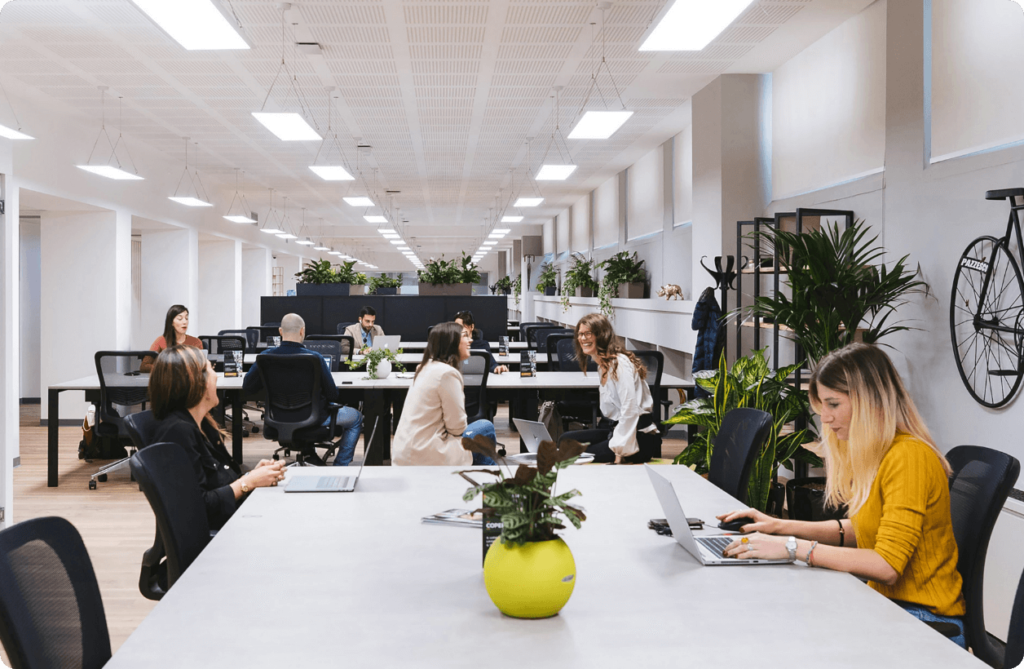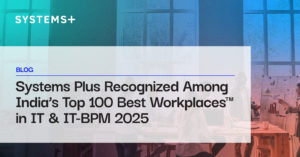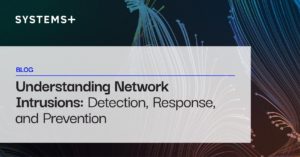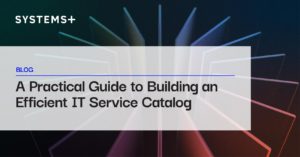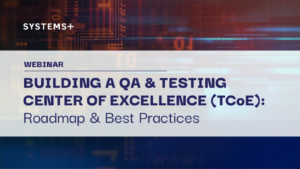Sapan:
Welcome to Enabling Digital, the Systems Plus podcast series.My name is Sapan Choksi and I'm here today with a very exciting guest, Charles Griffith. Charles has been disrupting retail logistics for over 20 years, be it with behemoths such as Amazon to startups like Mile Zero and Quiet Platforms. Charles, it's great to have you here today.
Charles:
Thanks for having me.
Sapan:
Absolutely. It's our pleasure. So let's jump right in. Why don't we start by just you telling us how you helped build the foundation for Amazon logistics and how that led you to creating Mile Zero?
Charles:
Well, that's a big question. But I'll start with a lot of blood, sweat and tears, emphasis on tears. So I joined Amazon back in 2006 and this is kind of a familiar story for anyone who's met me before. But I joined when Amazon was still a startup. Amazon at that point, for people that don't recall and wish they could go back in time, was about 26 bucks a share. So that gives you some idea. I had joined after doing a startup that isn't listed in my public resume or LinkedIn called Three Data, which was a startup that was a global CRM solution for manufacturing of garments, which is ironic since this last thing I was working on was for American Eagle. But this startup was really before the growth of the internet and we had built a distributed system that allowed brands and private labels and manufacturers in Mexico to collaborate and to basically build out products, which were clothes, of course. A lot of this, with the emergence of things like blockchain and others are still going on and there's still a lot of innovation very similar in what we had started back in this particular period of time.
Unfortunately, for a number of reasons, one being that I learned an important lesson, never have a startup with guys that are already rich because they lose focus quickly. And the second being bad luck because whereas Mexico looked like it was poised to be a big player in those particular times with NAFTA and so forth, China ended up becoming a huge player in terms of manufacturing, as we all know. But the point was I was infected at that point with the desire to learn more about automation of supply chain. And so when Amazon came along, Amazon already had a reputation in those times of being great at logistics.
And so I joined the transportation team there and led the technology growth from 2006 through 2014. That began with, actualizing Prime, which had started in 2005, going through the category expansion where Amazon moved from BMVD to everything. And that required a lot of changes in terms of how you ship and then ultimately, injecting deeper and deeper into carrier networks and moving away from a dependency on enterprise carriers, enabling a lot of the local couriers that have become bigger couriers now. And then finally, leading what we had called transportation by Amazon, which is now called AMZL or Amazon Logistics, which was the creation of Amazon as a carrier. That included building out sort centers, building out better controls for line hall management, and then finally expanding its capabilities in terms of last mile, mostly for the enablement of products like fresh, but also for the launch of various marketplaces like India and China and to shift some of the dependencies off of carriers in places like the UK.
In about 2014, I realized, excuse me, that we were at the end of an era for building and now it was going to be all expansion and build out for the next five years. That's what I thought, five years, but it looks like it's going to be a lot more than five years. So as we moved on, I decided I'd go back and build the startup that I'd wanted to and I founded a company called Mile Zero. Mile Zero was a last mile platform.
It's interesting when you come out of the behemoths, as you mentioned, your view of the market is skewed in terms of everyone is competing with you when in fact, no one is. So whereas I thought there was a tremendous market for last mile, we were way early and it took time for that to catch up. But we built from the ground up a lot of ex-Amazonians. We delivered a product that started out with Noon in the Middle East, and then we found traction with Staples, Harvey Norman, a big retailer in Australia, and another large retailer called Endeavor Drinks in Australia, before getting acquired by HIG/ Capstone in 2019. And at that particular point, once we were kind of owned by private equity, we started focusing on an expansion into groceries.
And I'd probably still be there if it wasn't for a guy named Shaker Najran who came along. He'd approached me several times and said, hey, I want you to join this new startup I'm building. Well, it turned out this startup he was building was actually within a big, huge retailer called American Eagle Outfitters. And the idea was to combine all of the logistics for American Eagle and for other retailers into a sharing platform. And once they made a few big acquisitions, I decided, yeah, this is the place to go. And so I joined in 2022.
However, over the next couple of years, as we all know, in the tech field here, it was an interesting time where the focus shifted from big ideas to profitability. And so we went through a refocusing and ultimately changed the entire focus of the platform to be about using data science and inventory and intelligence to get positioning based on demand for retailers and developing basically a surety model where they could get delivery with a surety but not have a stake in which particular player made those deliveries. So almost a round trip back to the beginning of the story. And so I just recently left after we got back on the right path here. And now I'm looking forward at what's next.
Sapan:
Well, that's awesome. So you've been, well, even though you work with Amazon, but you worked with them really in a well-funded startup stage. So it's pretty interesting. You sort of have that experience of doing it all big and small and meaningful things across the board. That's pretty exciting. But I guess I want to touch on retail logistics. It's a very big word, to be perfectly honest, right? So how do you sort of look at it? How do you define it? I'd love to sort of understand your thoughts on the state of the industry today. And more than that, where are you seeing as the core friction points today?
Charles:
Well, it's interesting. You're right. It is a big word and it covers a lot of ground. I think it's also an evolutionary word where it's changed over time. If you look at Amazon, for example, we never thought of transportation as part of the product originally, right? It was a cost center. And people just, you know, and lesser retailers at that particular time, effectively outsourced the customer relationship for delivery. So it's become a key part of what retailers do. So I think retail logistics is very much a term that refers to how do you interact with your customer? And that includes everything from inbound, you know, getting the products that you want to how it's delivered and all of those interchanges. And I think, you know, it's changing and it's always changing. There are years when retailers over buy and now it's all about how do we get rid of our old stock, right, at a profitable amount. And how do we basically serve customer demand? We saw how during the pandemic, how ineffectively that was done, right, which created scarcity and created inflation. So it's also a big indicator of how the economy is going to go, right, because so much of every country is tied to retail.
The other thing is I think that retail logistics is moving away from something that for the last 100 years has been very manual, right? There are still a tremendous number of warehouses around the world that have spreadsheets that are managing off a hook or crook based on the guy that's there and been there for 20 years. And that is all changing. It's not changing by enterprise logistics solutions, right, because that's cost prohibitive for many companies, but it's changing based on the availability and evolution of technology. And so I think, you know, the first step was we saw more access to tools that's changing the way people operate. The next is we're starting to see more automation. And really, I think as we move into the future, just like we're talking about advances in AI and other forms of technology evolution, logistics is going to move to being more of an orchestrated and executed transaction that's done by machines versus humans.
Sapan:
Oh, perfect. I want to touch on something you just talked about, being customer centric. And I've heard you say this in the past, saying, well, the success of the customer has to be at the forefront of thinking. So my take on that is I might have built the most amazing product, but if no one's using it, then, well, according to me, that product is a failure. Do you agree?
Charles:
Oh, absolutely. I think that in previous eras, you could be very successful and have a product that's not leveraged. For example, you could have an enterprise tool that sits in a warehouse that nobody uses but the backer is paid for it, right? And some companies would be completely satisfied with that. I think that one of the big learnings I had through Amazon was to think very broadly about who your customer is. And coming from games and other industries, I believe in making sure that customers are fully engaged with your product, right? And that takes interviewing them, understanding how the product's learnt and actually designing and collecting information without interaction. That's one of the big things that I think people forget to do, but you have to be able to effectively understand why your product's not functioning, even if you can't interact with a human. And so building those types of collections, whether it's sensory or whether it's just basically the way you monitor and track the way the activity within your platform, those are key aspects, but you're dead on. If you don't have a product that people use, you won't live very long in any industry.
Sapan:
I want to touch a little bit on your background initially in the games industry, right? How have you seen that help you through your career? Because it is a very different step that you took, but I'm sure there were probably a lot of learnings, which you're probably even used to that.
Charles:
You're dead on. I think a lot of people are aware of Amazon's two pizza team, right? The number of people, regardless of function that can consume two pizzas is a team almost like microservices for organizations. That idea is not new to me, wasn't new to me when I arrived at Amazon back when I was doing games, which we're going back into the dark ages and please don't Google it and find any of my games on YouTube. I'm already writing apologies on a daily basis. But back in those days, we didn't have monolithic teams that were focused. It was a very emerging industry where there wasn't even an established market. You know, I started out doing games for the Amiga was my first one. And then PC and then moved on to Super Nintendo Sega Sega Genesis, just to give people an idea of the era. And in those particular times, I guess, fortunately, unfortunately, yes, I consider it like Amazon. One of two times I poisoned the world, not necessarily for good. But in any event, when we were working on those games, many times would be five or eight people, you know, max that were working on these games. You'd have an artist, you'd have a project manager, you'd have a couple of engineers, you'd have a sound artist that was basically using very, very, very difficult tools in those times. And, you were working together and it was a shared vision so that was one of the things that I took away. And I think it's changed the way that I become a manager and a leader is your role could change any particular day, so, lead with humility and lead more for the benefit of the team than the individual. And sure everyone is working kind of at their maximum level, because it's the strength of everyone in the team, almost like an equalizer on a stereo, right? If you're getting the max out of all particular limited resources, you're moving more effectively than some of these big orchestras that have the guy with the bell that hits it once every 10 songs.
Sapan:
No, definitely, that makes a lot of sense. So pulling you back to your current area of expertise, so looking at the rise of omnichannel, fundamentally, retailers are facing a lot of pressure to manage their costs. And of course, the complexity of the last mile customer fulfillment is becoming more and more sort of, complex, to say the least. So how do you see technology helping quell some of those challenges or the role that technology plays in helping retailers address these challenges? And fundamentally, how do you see technology play a major role in optimizing especially retail logistics, the last mile delivery challenges that I believe pretty much anyone you talk to faces these days? Or is it an unsolvable problem?
Charles:
I think it again is changing over time. You know, a lot of these things, think about the consumer and then we'll work backwards to the problems, right? Consumer expectations are very much driven by a moment in time. If we go back to COVID, right? Amazon was able to relax and had to relax some of the expectations just based on labor and ability to reach customers. So you know, that two day promise was no longer an expectation.
And as the pandemic lifted, I would still argue that they weren't moving as aggressively, right? Because of the cost constraints and so forth. But if you look now, they're back up to the speeds they were pre-pandemic from my estimates. And if we just, if we expand that out, there are times when a retailer needs to compete against somebody like an Amazon and be able to deliver it, that kind of a very competitive speed and quality and they have limited partners to work with. And so, their ability to sell an item versus their competitor becomes how well can I negotiate with, you know, carrier X, Y or Z? And I think this was kind of the basis originally of Amazon or of Quiet was to consolidate this and give more democratization to customers. I think the entire industry is moving in that direction. I think that what we're going to see is we're going to see more automation and we're going to see non-traditional carriers. We’ve already have seen the foray of Uber and others moving into the space, right, to offer retailers directly other options besides the enterprise carriers or local couriers. I think we'll continue to see more and more options to get to the last mile that will continue to bring down costs and improve the scale that it can be offered because we just can't have the world working the way it is now.
The other thing that I think is going to change is the way that buying and fulfillment happen. With the expansion of AI, we're going to stop seeing people shop the way they do now. We have a very on-demand kind of e-commerce world today. You know, I think about something and I go out and order it, right? Oh, I need a hammer. Well, it'll be here in two days. Oh, they could deliver it for, you know, more with a greener method in five days. I really don't need the hammer in two days, but I feel entitled to get it in two days, so I'm going to take the two-day option. When we start seeing an aggregation of purchasing from an automated shopper, an AI shopper that's basing the purchases based on cost and based on need from an availability perspective, that aggregation will start to translate into more of like a B2B delivery to consumers at their homes. Obviously, I hate to keep going back to Amazon, but they've been so early and smart in so many ways.
If you look at things like Amazon Day, that's what Amazon's trying to instill in customers, try and get more things on the same day for less. I think that as you start to automate the purchasing process and move away from this consumer-driven model, we're going to see it because economically, it doesn't make sense to do everything as a per-parcel delivery. We should be looking at larger deliveries based on the quantities that are coming to people's houses. Right.
Sapan:
And how do you see the new trend that is taking shape in the retail world where, you know, they are sort of charging customers for returns, et cetera, at least if it's pickup from home, right?
Charles:
Obviously, it's a strategy that, you can free returns in store, but that's to drive traffic to the store and they know they're going to be able to sort of do this. But Amazon doesn't have that option as such. And I know from what I've read, et cetera, and of course, you probably read a lot more around that, you know, in terms of how the reverse of that works, it's still a last mile problem just in a different way.
Sapan:
So how do you see that challenge being addressed? Reverse logistics specifically?
Charles:
Yeah, reverse logistics, especially when I need to return something, but my expectation is somewhat the same from a service point of view, but of course, it works very differently. So I think there's a number of factors with reverse logistics. The first one is that what does the consumer really care about? I care about getting my money back, right? So what they're really caring about is how quickly will that retailer give me my money back? In some cases, no, because it doesn't make sense to return the item, as we've seen, right, but they don't want to become a target for fraud either. So there's a balancing act there. You can't tell people don't return something and it gets on the internet and everybody starts buying and returning those items. So you know, what it comes down to is how do you create an effective reverse logistics? And obviously, you can't expect that the items coming back are in mint condition, right? So you have to introduce grading. It can be very complex based on the type of product. Electronics, for example, are extremely difficult. And ultimately, as a retailer, you want to be able to get if it's a product that has a significant margin, you'd like to recoup some of that. So I think reverse logistics are very difficult. They require strategic planning by companies.
Sapan:
You're absolutely right. It's such a complicated problem. And it's the balancing act. I actually never thought about the balancing act, but you're absolutely right, because it cannot make sense for the retailer to get back at least say, socks, I don't like them and I'm returning them. But it does tie back to what you said earlier about retail logistics. You know, again, reverse logistics were never really a consideration about a product early on.
Charles:
Of course, they were, right? If you look the way brands would plan, they'd plan for a certain conversion level and then they would have seconds that would go to outlets like Ross and others. But it wasn't done collectively and it wasn't done kind of at an individual skewer item level when you're looking at the revenue per unit or you're looking at the cost per transportation. Now you kind of have to factor that in and aggregate all of these factors.
Sapan:
So, I'm going to talk a little bit about the future of retail logistics and the role technology is already playing, but you touched, you mentioned a couple of times on AI and you said that AI has a big role to play. How so do you mean? And what I mean by that is like, what are some examples that you've seen that are really leveraging AI in retail logistics and how do you feel that AI will help further along?
Charles:
That's another big area. I think that in logistics, obviously we've seen a number of different types of data science and AI techniques used for a long time. As I alluded to with things like prime, that is based on machine learning and, you know, initially and other aspects to get more out of a carrier's network than they advertise. As we're looking forward though, I think where we start to see more automation, we're going to start to see, you know, large planning systems that are going to be planning the traversal or movement of a package over multiple carriers, multiple different modes and basically revising that continuously in real time. I think that that's going to be unlocked based on more sensory data and more tracking than just say the traditional EDI 214 where you're getting the five or six updates on your delivery of your package that you'd see through any e-commerce. I think these systems are going to start to really start routing things much more like an air traffic control system.
The other thing, so a lot of that is on the planning and orchestration of packages and putting packages together to get a lower cost per delivery. So that's where that's going to go and I think it's critical to be able to continue to reduce the cost per shipment.
I think the other thing that we're going to start to see is we're going to start to see frameworks for execution so that the partners in a particular transaction start to, whether they standardize or whether they're forced to start, you know, surfacing APIs that provide very similar information, we're going to need more real time control from partners to effectively automate this type of flow and I think we're going to see that as well. And as we continue on, we all know that, we're going to see more automation. I don't, I think there'll be special reasons for things like drones, right, for per package. But I think we're going to start seeing the mass of shipments start to move into a much more automated process that's going to be driven by some big computing.
Sapan:
And do you see retailers coming together to solve this, I don't want to say, or optimize is probably the right word, the whole loss.
Charles:
I think the answer is both. There certainly, the large retailers that have the volume do that today, right. And they get the price negotiations with partners as a result. It's the midsize to smaller. Some of these growth brands that we see need the ability to access that. And I think we'll start to see more and more consortiums of groups of those types of retailers collecting together, whether it's behind the facade of a marketplace or an interim player like that was kind of the intent of quiet platforms. But I think that's an overdue mechanism because what we're not going to see is we're not going to see the carriers themselves give those common rates to everyone. It just would undermine their businesses. But if these consortiums are able to give them back a better sense of consistency and reduce their costs for pickup, then it's kind of a two way street, just as an example, right. It's very costly to go to a number of places for pickups, which is why they have stores and so forth for injecting into their network. But things are going to continue to get more complex. So I think we'll see movement in all facets. But it has to make business sense as well.
Sapan:
Absolutely. And in fact, I'm glad you touched on the problem that quiet platform is trying to solve because, basically, there has to be, for the, let's call it the small and the middle retailer, size retailer, there has to be a way to come together even if they don't want to outright say it to try to create some rather call it cost savings, some leverage, something or the other. And I guess that's exactly the problem you were trying to solve.
Charles:
Absolutely. I think it’s interesting. Most customers still just expect to get it for free, right? I think I'm constantly when I go, I try to shop across a number of different experiences. And when I'm hit with a $30 transparent fee to ups for, you know, say, plant delivery or something like that, I'm just like, that is exorbitant. That is like a decision moment where I decide should I just go down the street to a nursery and get it get it there instead. So I think that, it has to change for some of the local businesses to be able to survive and some of the smaller businesses to survive. And again, these smaller businesses, the ones that really have something unique are going to become the next generation of larger. And so if they don't have that ability to be viable earlier, we're really hurting our entire landscape of choice and selection. So I do think that that things are going to move in that direction. But they're going to move in that direction because somebody is going to figure out how to do it profitably. And the hardest thing, I'll tell you this, one of the hardest things to do these types of missions is you have to have volume to make a difference. And so the key is how do you get enough small players to aggregate the number of volume that's significant to the carriers you want to introduce it to.
Sapan:
You're absolutely right. I mean, of course, you know this inside out, but you're bang on. Without the volume, none of this works.
Charles:
I know it because I've got a lot of tears behind it. So don't make me cry publicly.
Sapan:
So well, speaking of the public, my last question to you, well, I know we can keep talking, but we are about to run out of time. So my last question to you is, so I want to give you, I would like you to give something back to our listeners, those who are extremely interested in the retail logistics industry. What areas do you think can be future disruption areas so that some young guy coming in looking at solving a problem in this sort of area can start thinking, yeah, I can go after that. Or if you've not thought about that, what are the disruption areas that you will definitely see in the next five years?
Charles:
I mean, I think about that all the time, right? There are so many different areas that are yet to be disrupted. And I think, you know, so many people think of the costly ways to disrupt, right? We have a lot of large scale automation that's available, which is great for those companies that can afford it. It's the small ones that can't. And this is where, there are mobile solutions that could be done that could continue to move those particular supply chains towards a mechanized automated manner by creating a repeatable process. I think that's a great area for younger engineers and product managers to focus on. I think there are a number of very creative ways that you could improve gig related access and create consortiums of people that are available for things. I mean, if you look at things like DoorDash and you look at Uber and so forth, these all basically created more of a mechanization of a set of resources that were already there, but it made them more accessible. And so I think there's a lot to be done there in the logistics space that no one's really working too hard on.
There are a lot of people that look at the experience, but don't look at the business as they try and solve these problems. So what I'll just plant in any of the entrepreneurs out there that want to look at this space, the logistics delivery is really a series of exceptions and a lucky event at the end where the customer gets their delivery. And most of what we do in this space is figure out how to reduce those exceptions and those failures. So if you can provide a more efficient, effective way to get something from here to there, whether we're talking reverse logistics, whether we're talking inbound of moving a product into a marketplace or whether we're talking about the delivery of that product to a customer, if you can make that more visible, repeatable and efficient, you're going to be very successful and you're going to have something that's going to garner a lot of traction.
Sapan:
But Charles, I'm going to hold you back for two more minutes because you touched on something which got me thinking. Why do you feel that logistics in general is such an under invested, at least from a technology point of view, such an under invested industry?
Charles:
I don't think that it's necessarily under invested. I think that there are a lot of companies that are building bespoke solutions. And that's where I think that misinvested might be the way to speak to it. I used to see this with games as well, right? Going back to games, everyone had to write their own graphics drivers, their sound drivers, etc early on in gaming, and then all of a sudden, players came along that started to put that out and then eventually the actual game platforms would put out effective platforms to enable developers.
I think we're at a very early period of time, as I said, even though it seems we've been looking at e-commerce for 20 years or so, 20 plus years, we're very early in terms of thinking about logistics as being a service that's a common platform for customers, right? Look at how many different ways it happens. Look at by country, how different the experience is. There isn't really, there hasn't been the business driver there. As I said, we've had very big companies like Manhattan and others that have attacked the ability for a large player to build a very effective solution. But when you get down into all of these bespoke smaller players, there hasn't been an effective way of creating repeatability so everyone does it the way they can do it, which varies. So more opportunity for all of us, right?
Sapan:
Yes, absolutely. It's an exciting time. Awesome. Well, Charles, thank you once again for joining us on this podcast of Enabling Digital with Systems Plus. It's been really, really fantastic for me to get to learn and understand your thoughts and get to know you a lot better as well. And I'm sure our listeners really appreciate it.
Charles:
Thank you, Sapan. It was a great opportunity and I enjoyed the questions. A lot of times we don't get into some of the automation and AI and the direction where we're headed in the future. I think sometimes we focus too much looking backwards and the real opportunity is to look forwards. Thank you.
